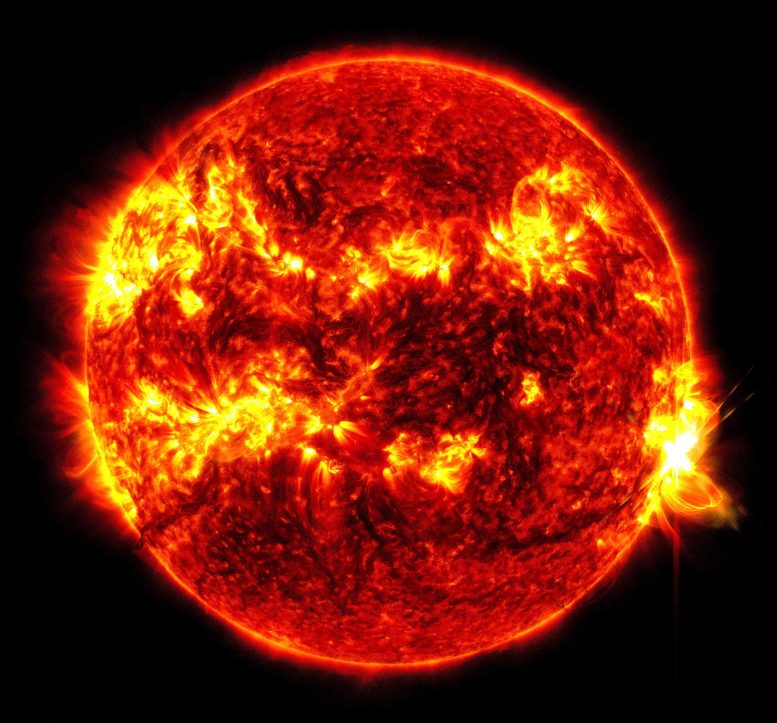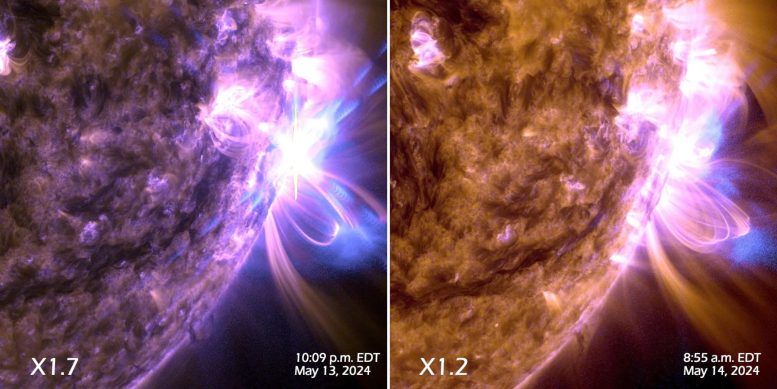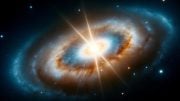
NASA’s Solar Dynamics Observatory captured this image of a solar flare – as seen in the bright flash on the right – on May 14, 2024. The image shows a subset of extreme ultraviolet light that highlights the extremely hot material in flares and which is colorized in red and yellow. Credit: NASA/SDO
NASA’s Solar Dynamics Observatory, which constantly watches the Sun, just captured images of 3 powerful X-class solar flares. The first was classified as an X1.7 class flare and peaked at 10:09 p.m. ET on May 13, 2024. The second was classified as an X1.2 class flare and peaked at 8:55 a.m. ET on May 14, 2024. The third was classified as an X8.7 flare and peaked at 12:51 p.m. ET on May 14, 2024.
Solar flares are intense bursts of radiation that emanate from the Sun’s surface, often accompanied by the release of charged particles. These eruptions occur due to the sudden release of magnetic energy stored in the Sun’s atmosphere.
When directed towards Earth, the radiation from a solar flare can disrupt the ionosphere, affecting radio communications and GPS systems. The energetic particles can also pose hazards to satellites and astronauts, potentially damaging electronics and increasing radiation risks. On the ground, particularly intense flares can induce currents in power lines, leading to voltage instabilities and power outages.

NASA’s Solar Dynamics Observatory captured these images of the solar flares – as seen in the bright flash on the right sides of the images – on May 13 and May 14, 2024. These images show a subset of extreme ultraviolet light that highlights the extremely hot material in flares and which is colorized in purple, pink, and gold. Credit: NASA/SDO
Solar flares are classified based on their brightness in the X-ray wavelengths, observed from satellites like NOAA’s GOES spacecraft. The classification system consists of five categories:
- A-Class: the weakest flares, which have little to no effect on Earth.
- B-Class: a bit stronger, but still generally inconsequential in terms of space weather.
- C-Class: stronger yet, with some flares capable of causing minor radio blackouts in polar regions.
- M-Class: moderate flares that can cause brief radio blackouts that affect Earth’s polar regions and minor radiation storms.
- X-Class: the strongest flares, which can trigger planet-wide radio blackouts and long-lasting radiation storms.
Understanding and predicting solar flare activity is crucial for mitigating their potential disruptions, particularly as our reliance on technology susceptible to space weather increases. Agencies like NASA and the NOAA Space Weather Prediction Center monitor the Sun continuously to provide timely warnings to safeguard technological systems and human activities both in space and on Earth.









Be the first to comment on "NASA Captures Triple X-Class Solar Eruptions – Including a Powerful X8.7 Flare"